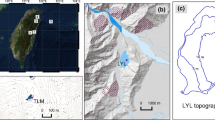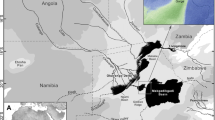Abstract
Diatom, rock magnetic, geochemical, and lithological studies of a sediment core from Paramushir Island (northern Kuril Archipelago) trace environmental shifts from bog to salt-water lagoon to freshwater lake over the past 10,000 14C BP. Organic-rich mesic landscapes dominated the southern island until ~8200 14C BP. Transgression of the Sea of Okhotsk onto the island began sometime after 8200 14C BP, resulting in the formation first of a salty (~8200–5700 14C BP) then a brackish (~5700–5200 14C BP) lagoon. With lowering of sea level after 5200 14C BP, a freshwater lake formed, which has remained to the present day. This history parallels regional trends in the Russian Far East, where maximum sea levels occurred between ~8000 and 4600 14C BP, peaking at ~6400 14C BP. Sandy levels within the lake core suggest four intervals of aeolian activity (~4900–4800 14C BP; 4300–3800 14C BP; 3200–3000 14C BP; 1900–900 14C BP), perhaps related to drier than present climates. Palynological data indicate a dominance of Pinus pumila–Duschekia kamtschatica shrub tundra in the lowlands ~8200–5800 14C BP, marking the Holocene thermal maximum. This vegetation contrasts to modern, which established ~5800 14C BP and is a mix of coastal meadow, Betula–Salix low shrub tundra, and scattered Pinus and Duschekia thickets. The palynological record shows little response to mid-to-late Holocene climatic fluctuations except for a decrease in Pinus shrubs perhaps caused by changes in snow cover and/or summer temperature during the Little Ice Age.







Similar content being viewed by others

References
Anderson PM, Lozhkin AV, Minyuk PS, Pakhomov AYu, Solomatkina TB (2009) Characteristics of sedimentation in a lowland lake on Paramushir Island (northern Kuril Islands). In: Environment development of East Asia in Pleistocene-Holocene. Proceedings of geographic and paleogeographic conference, Russian Far East, Dalnauka, Vladivostok, pp 17–18
Andreev VN (1980) Rastitel’nost’ i pochvy subarcticheskoi tundry: sbornik nauchnykh trudov (1980) (Redactor V.N. Andreev). Nauka, Novosibisrk (Vegetation and Soils of Subarctic Tundra. Siberian Branch Yakutia Subdivision Biological Institute USSR Academy of Sciences. Novosibirsk, Russia)
Bigelow NH, Edwards ME (2001) A 14,000 yr paleoenvironmental record from Windmill Lake, Central Alaska: lateglacial and Holocene vegetation in the Alaska range. Quat Sci Rev 20:203–215
Bond G, Showers W, Cheseby M, Lotti R, Almasi P, deMenocal P, Priore P, Cullen H, Hajdas I, Bonani G (1997) A pervasive millennial-scale cycle in North Atlantic Holocene and glacial climates. Science 278:1257–1266
Burov BV, Nourgaliev DK, Yasonov PG (1986) Paleomagnitnyi analiz Izdatel’stvo Kazanskogo Universiteta, Kazan (Paleomagnetic analysis. KGU, Kazan)
Cherepanova MV, Lozhkin AV, Anderson PM (2009) Diatoms from Kuril lake sediments as high-resolution data for Pleistocene paleogeographic reconstructions. In: Environment development of East Asia in Pleistocene-Holocene. Proceedings of geographic and paleogeographic conference, Russian Far East, Dalnauka, Vladivostok, Russia, pp 43–44
Czerepanov SK (1995) Vascular Plants of Russia and Adjacent States (the former USSR). Cambridge University Press, New York
Day R, Fuller M, Schmidt VA (1977) Hysteresis properties of titanomagnetites: grain-size and compositional dependence. Phys Earth Planet Inter 13:260–267
Dirksen V, Dirksen O, Diekmann B (2013) Holocene vegetation dynamics in Kamchatka, Russian Far East. Rev Palaeobot Palynol 190:48–65
Gorbarenko SA, Goldberg EL, Kashgarian M, Velivetskaya TA, Zakharov SP, Pechnikov VS, Bosin AA, Psheneva OYu, Ivanova ED (2007) Millennium scale environment changes of the Okhotsk Sea during Last 80 kyr and their phase relationship with global climate changes. J Ocean 63:609–623
Grishin Y (2000) Notes about the phytogeography of Northern Kurils. Izv Rus Geogr Soc 4:65–76
Grishin SY, Barkalov VY, Kuznetsova TA (2005) Rastitel’nyi pokrov ostrova Onekotan (Kuril’skiye ostrova). Komarovskiye chteniya, S: 80-100. Dal’nauka Dsgesk 51, Vladivostok (The Vegetation Cover of Onekotan Island (Kuril Islands). Komorov’s Reading: pp. 80–100. Dal’nauka 51, Vladivostok)
Heiri O, Lotter AF, Lemcke G (2001) Loss on ignition as a method for estimating organic and carbonate content in sediments: reproducibility and comparability of results. J Paleolimnol 25:101–110
Kato M, Fukusawa H, Yasuda Y (2003) Varved lacustrine sediments of Lake Tougan-ike, western Japan, with reference to Holocene sea-level changes in Japan. Quat Int 105:33–37
Korotky AM (2002) Palynological characteristics and radiocarbon data of late Quaternary deposits of the Russian Far East (lower Amur valley, Primor’ye, Sakhalin Island, Kuril Islands) In: Anderson, PM, Lozhkin, AV (eds) Late Quaternary Vegetation and Climate of Siberia and the Russian Far East (Palynological and Radiocarbon Databases). North East Science Center, Magadan, pp 257–369
Korotky AM, Karaulova LP, Troitskaya TS (1980) Chetvertichnyye otlozheniya Primor’ya. Nauka, Novosibirsk (The Quaternary Deposits of Primor’ye. Nauka, Novosibirsk Russia)
Korotky AM, Pushkar VS, Grebennikova TA, Razjigaeva NG, Karaulova LP, Mokhova LM, Ganzey LA, Cherepanova MV, Bazarova VB, Volko, VG, Kovalyukh NN (1997) Morskiye terrasy i chetvertichnaya istoriya shel’fa Sakhalina. Vladivsotok, Dal’nauka, Vladivostok (Marine terraces and Quaternary history of Sakhalin shelf. Dalnauka, Vladivsotok)
Korotky AM, Razigaeva NG, Grebennikova TA, Ganzey LA, Mokhova VB, Sulershitsky LD, Lutaenko KA (2000) Middle- and late-Holocene environments and vegetation history of Kunashir Island, Kurile Islands, northwestern Pacific. Holocene 10:311–331
Korotky M, Anderson P, Lozhkin A, Matrosova T, Solomatkina T, Brown T, Brubaker L, Grebennikova T, Mokhova L, Hu F (2004) Development of landscapes in southeastern Primor'ye during the middle and late Holocene. In: Spatial and temporal changes in Quaternary environments of north east Asia. North East Interdisciplinary Science Institute Russian Academy of Sciences, Magadan, pp. 12–49.
Korotky AM, Volkov VG, Grebennikova TA, Razzhigaeva NG, Pushkar VS, Ganzei LA, Mokhova LM (2005) Far East. In: Velichko AA (ed) Cenozoic climate and environmental changes in Russia. Geological Society of America Special Papers 382, pp 121–137
Krammer K, Lange-Bertalott H (1986) Bacillariophyceae. Süßwasserflora von Mittleeuropa, Band 2, Teil 1, Stuttgart
Krammer K, Lange-Bertalott H (1988) Bacillariophyceae. Süßwasserflora von Mittleeuropa, Band 2, Teil 2, Stuttgart
Krammer K, Lange-Bertalott H (1991) Bacillariophyceae. Süßwasserflora von Mittleeuropa, Band 2, Teil 3, Stuttgart
Lauquet GO, Gruau G, Dia A, Riou C, Jaffrezic A, Henin O (2001) Release of trace elements in wetlands: role of seasonal variability. Water Res 35:943–952
Lozhkin AV, Anderson PM, Goryachev NA, Minyuk PS, Pakhomov AYu, Solomatkina TB, Cherepanova MV (2010) Pervaya ozernaya letopis’ izmenenii klimata i rastitel’nosti Severnykh Kuril v golotsene. Doklady Akademii Nauk. Tom 430: 541-543 (First Lake Record of Holocene Climate and Vegetation Change from the Northern Kuril Islands. Doklady Academii Nauk 430:541–543)
Maeda Y, Matsuda I, Nakada M (1994) Holocene sea-level change along the Okhotsk Sea in Hokkaido, Japan. Bull Yamagata Univ 13:205–229
Melekestsev IV, Kurbatov AV (1997) Chastota krupneishikh paleoseismicheskikh sobytii na severo-zapadnom poberezh’e i Komandorskoi kotlovine Beringova morya v pozdnem pleistotsene i golotsene. Vulkanol Seismol 3:3–11
Minyuk PS, Subbotnikova TV, Anderson PM, Lozhkin AV (2013) Rock magnetic properties of the Lake Pernote sediments (Paramushir Island) as an indicator of the changes in sedimentation conditions. Izv Phys Solid Earth 49:120–129
Pakahomov AY (2011) Pozdnepleistotsen-golotsenovaya paleogeographiya pribrezhnykh nizmennostyei ostrova Paramushir (Severnyye Kurily). Qvarter vo vsem ego mnogoobrazii. Fundamental’nyye problemy, itogi izycheniya i osnovnyye napravleniya dal’neishikh issledovanii. Materialy VII Vserossiskogo soveshaniya po izucheniyu chetvertichnogo perioda, Appatity (12-17. 09) tom 2:141–143
PALE (1994) Research protocols for PALE: Paleoclimates of Arctic lakes and estuaries. PAGES Workshop Report Series, Bern
Ponomareva VV, Kyle PR, Melekestsev IV, Rinkleff PG, Dirksen OV, Sulerzhitsky LD, Zaretskaia NE, Rourke R (2004) The 7600 (14C) year BP Kurile Lake caldera-forming eruption, Kamchatka, Russia: stratigraphy and field relationships. J Volcanol Geotherm Res 136:199–222
Proshkina-Lavrenko AI, Glezer ZI, Makarova IV (eds) (1974) Diatomovye vodorosli SSSR: iskopaemye i sovremennye (Vol. 1) (Diatoms of the USSR: Fossil and Modern). Nauka, Leningrad
Razjigaeva NG, Korotky AM, Grebennikova TA, Ganzey LA, Mokhova LM, Bazarova VB, Sulerzhitsky LD, Lutaenko KA (2002) Holocene climatic changes and environmental history of Iturup Island, Kurile Islands, northwestern Pacific. Holocene 12:469–480
Razjigaeva NG, Grebennikova TA, Ganzey LA, Mokhova LM, Bazarova VB (2004) The role of global and local factors in determining the middle to late Holocene environmental history of the South Kurile and Komandar Islands, northwestern Pacific. Palaeogr Palaeoclim Palaeoecol 209:313–333
Razjigaeva NG, Ganzey LA, Belyanina NI, Grebennikova TA, Ganzey KS (2008) Paleo-environments and landscape history of minor Kuril Islands since the late glacial. Quat Int 179:83–89
Sakaguchi Y (1983) Warm and cold stages in the past 7600 years in Japan and their global correlation. Bull Dep Geogr Univ Tokyo 15:1–31
Sato MM, Narita HN, Tsunogai S (2002) Barium increasing prior to opal during the last termination of glacial ages in the Okhotsk Sea sediments. J Oceanogr 58:461–467
Sharma S, Joachimski M, Sharma M, Tobschall HJ, Singh IB, Sharma C, Chauhan MS, Morgenroth G (2004) Late glacial and Holocene environmental changes in Ganga plain, Northern India. Quat Sci Rev 23:145–159
Stuiver M, Reimer PJ (1993) Extended 14C database and revised CALIB radiocarbon calibration program. Radiocarbon 35:215–230
Urusov VM, Chipizubova MN (2000) Rastitel’nost’ Kuril: voprosy dinamiki i proiskhozhdeniya. DVO RAN, Vladivostok (Vegetation of Kuril Islands questions of dynamics and origin. Russian Academy of Sciences, Far East Branch, Vladivostok, Russia)
Wilson TA, Amirbahman A, Norton SA, Voytek MA (2010) A record of phosphorus dynamics in oligotrophic lake sediment. J Paleolimnol 44:279–294
Wright HE, Mann DH, Glaser PH (1984) Piston corers for peat and lake sediments. Ecology 65:657–659
Yang DY, Kim JY, Nahm WH, Ryu E, Yi S, Kim JC, Lee JY, Kim JK (2008) Holocene wetland environmental change based on major element concentrations and organic contents from the Cheollipo coast, Korea. Quat Int 176–177:143–155
Yudovich YE, Ketris MP (2011) Geokhimicheskiye indikatory litogeneza (litologicheskaya geokhimiya). Geoprint, Syktyvkar
Acknowledgments
This research was supported by the: U.S. National Science Foundation (ARC-0508109; Ben Fitzhugh, PI); Russian Foundation for Fundamental Research (15-05-06420, 14-05-00573 to Lozhkin and Minyuk); Far East Branch Russian Academy of Sciences (15-I-2-067, 15-I-6-073 Lozhkin and Minyuk; 15-I-6-073 Cherepanova). Additional support was provided by the University of Washington Center for Study of Demography and Ecology under the support from a Eunice Kennedy Shriver National Institute of Child Health and Human Development research infrastructure grant (R24 HD042828), the Sakhalin Regional Museum (Yuzhno-Sakhalinsk, Russia), and the Far East Branch of the Russian Academy of Sciences (IMGG: Yuzhno-Sakhalinsk, IVS: Petropavlovsk-Kamchatskiy), the Hokkaido University Museum (Sapporo, Japan), and the Historical Museum of Hokkaido (Sapporo, Japan). We thank Julya Korzun and William Brown for help in data and manuscript preparation and Tatiana Solomatkina for palynological analysis. We also thank two unnamed reviewers for their helpful comments.
Author information
Authors and Affiliations
Corresponding author
Electronic supplementary material
Below is the link to the electronic supplementary material.
Rights and permissions
About this article
Cite this article
Anderson, P., Minyuk, P., Lozhkin, A. et al. A multiproxy record of Holocene environmental changes from the northern Kuril Islands (Russian Far East). J Paleolimnol 54, 379–393 (2015). https://doi.org/10.1007/s10933-015-9858-y
Received:
Accepted:
Published:
Issue Date:
DOI: https://doi.org/10.1007/s10933-015-9858-y



